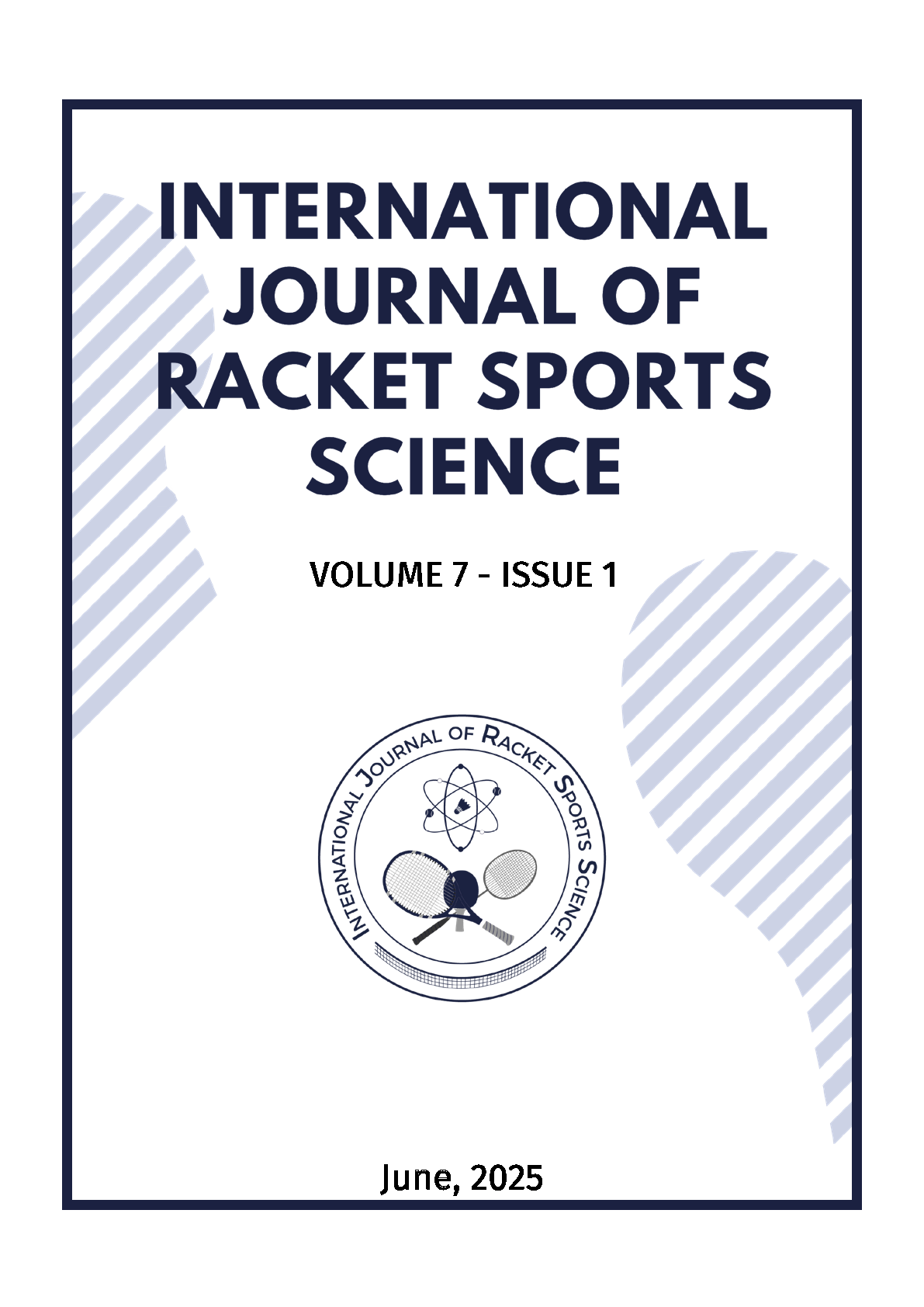Sliding benchmarks might prevent de-selection of talented badminton players
Abstract
Despite potential advantages of talent identification practices, the degree of bias in decision-making due to relative age and maturity timing remains a concern. To investigate the impact of relative age and maturity on selection processes, and to examine the possible influence of an intervention aimed at minimizing the impact of relative age and maturity biases, thirty-three boys (Mage = 12.43y ± 0.36y) invited to compete for Badminton Malaysia, completed three anthropometrical measures, eight physical performance assessments, and five motor coordination tests. These players were tracked throughout their career to determine pathway progression (i.e., dropout or continuation) and their level of success (i.e., season-end rankings). With regards to the relative age of athletes and the initial selection to the U13 team, findings revealed that younger and less mature players were disadvantaged, since their morphology, physical fitness, and motor capacities were less developed than their peers. A sliding benchmark intervention was applied, where raw scores were adjusted. Although, the dropout rate from the U13 team was high (24/33 players, 73%), 6 of 9 remaining players of the national team achieved exceptional results, which were evident six years later. As a result of the sliding benchmark intervention, two relatively younger, late maturers with superior motor competence scores, were selected to the elite sport school. Without this intervention, both players might never have won the U21 World Championships. This paper examines the pathway of these competitive badminton athletes and discusses the potential value of applying a sliding benchmark intervention in competitive sport selection settings.
References
2. Balyi, I., Way, R., & Higgs, C. (2013). Long-term athlete development. Human Kinetics.
3. Bar-Eli, M., Lidor, R., Lath, F., & Schorer, J. (2024). The feudal glove of talent-selection decisions in sport–Strengthening the link between subjective and objective assessments. Asian Journal of Sport and Exercise Psychology, 4(1), 1-6.
4. Bruininks RH, Bruininks BD. BOT-2: Bruininks- Oseretsky Tests of Motor Proficiency. 2nd ed. Minneapolis: AGS Publishing; 2016
5. Chapelle, L., Pion, J., Clarys, P., Rommers, N., & D’Hondt, E. (2023). Anthropometric and physical performance determinants of young tennis players progressing through a talent identification and development programme. International Journal of Sports Science & Coaching, 18(5), 1469-1477.
6. Cometti, G., & Cometti, D. (2007). La pliométrie: Méthodes, entraînements et exercices. Chiron.
7. Council of Europe. Committee for the Development of Sport. EUROFIT: Handbook for the EUROFIT tests of physical fitness. Rome: Secretariat of the Committee for the Development of Sport within the Council of Europe; 1988
8. Malina, R. M., Cumming, S. P., Rogol, A. D., Coelho-e-Silva, M. J., Figueiredo, A. J., Konarski, J. M., & Kozieł, S. M. (2019). Bio-banding in youth sports: background, concept, and application. Sports Medicine, 49(11), 1671-1685.
9. Faber, I. R., Oosterveld, F. G., & Nijhuis-Van der Sanden, M. W. (2014). Does an eye-hand coordination test have added value as part of talent identification in table tennis? A validity and reproducibility study. PloS one, 9(1), e85657.
10. Gulbin, J. P., Croser, M. J., Morley, E. J., & Weissensteiner, J. R. (2014). A closer look at the FTEM framework. Response to “More of the same? Comment on ‘An integrated framework for the optimisation of sport and athlete development: A practitioner approach’”. Journal of Sports Sciences, 32(8), 796-800.
11. Hill, M., John, T., McGee, D., & Cumming, S. P. (2023). Beyond the coaches’ eye: Understanding the ‘how’and ‘why’of maturity selection biases in male academy soccer. International Journal of Sports Science & Coaching, 18(6), 1913-1928.
12. Hohmann, A., & Siener, M. (2021). Talent identification in youth soccer: prognosis of U17 soccer performance on the basis of general athleticism and talent promotion interventions in second-grade children. Frontiers in Sports and Active Living, 3, 625645.
13. Jakobsson, J., Julin, A. L., Persson, G., & Malm, C. (2021). Darwinian selection discriminates young athletes: The relative age effect in relation to sporting performance. Sports Medicine-Open, 7, 1-18.
14. Khamis HJ and Roche AF. Predicting adult stature without using skeletal age—the Khamis-Roche Method. Pediatrics 95: 504–507, 1995.
15. Lohman TM, Roche AF, Martorell R. Anthropometric standardization reference manual. Champaign IL: Human Kinetics; 1988
16. Malina et al, 2015
17. Matthys SPJ, Vaeyens R, Vandendriessche J et al. A multidisciplinary identification model for youth handball. Eur J Sport Sci 2011; 11(5): 355-363
18. Mohamed, H, Vaeyens, R, Matthys, S, Multael, M, Lefevre, J, Lenoir, M, and Philippaerts, R. (2009) Anthropometric and performance measures for the development of a talent detection and identification model in youth handball. J Sport Sci 27: 257–266,
19. Norjali, R., Torfs, M., Mostaert, M., Pion, J., & Lenoir, M. (2017). Predicting judo champions and medallists using statistical modelling. Archives of Budo, 13, 161-167.
20. Pion, J., Lenoir, M., Vandorpe, B., & Segers, V. (2015). Talent in female gymnastics: a survival analysis based upon performance characteristics. International journal of sports medicine, 94(11), 935-940.
21. Pion, J. (2024). From potential to performance-The power of tools for talent identification and development.
22. Robertson, K., Pion, J., Mostaert, M., Norjali Wazir, M. R. W., Kramer, T., Faber, I. R., Vansteenkiste, P.& Lenoir, M. (2018). A coaches’ perspective on the contribution of anthropometry, physical performance, and motor coordination in racquet sports. Journal of sports sciences, 36(23), 2706-2715.
23. Robertson, K., Laureys, F., Mostaert, M., Pion, J., Deconinck, F. J., & Lenoir, M. (2022). Mind, body, and shuttle: multidimensional benchmarks for talent identification in male youth badminton. Biology of Sport, 39(1), 79-94.
24. Simonton, D. K. (1999). Talent and its development: an emergenic and epigenetic model. Psychological review, 106(3), 435.
25. Sweeney, L., Cumming, S. P., MacNamara, Á., & Horan, D. (2023). A tale of two selection biases: The independent effects of relative age and biological maturity on player selection in the Football Association of Ireland's national talent pathway. International Journal of Sports Science & Coaching, 18(6), 1992-2003.
Copyright (c) 2025 International Journal of Racket Sports Science

This work is licensed under a Creative Commons Attribution 4.0 International License.










_(1).png)
